It was a pretty miserable sail. Since rain was forecast later we had left Stanley as early as possible with the hope of beating it to Wynyard. We didn't make it. With only a quarter of our jib unrolled, we fairly flew down the coast in the big winds, but I was pretty much being continually drenched by cold, heavy rain the whole time. Down here, weather like this is frequent enough that it often becomes a choice of having it on a sailing day or a shore day. Since the wind was at least a strong one in the right direction, we got to endure it while underway.
When we arrived just outside of the town of Wynyard, we tucked into the lee behind Table Cape and set anchor in refreshingly flat water. It even stopped raining long enough for Maryanne to get the anchor down between showers. Time for a nice, cozy indoor day!
Then Maryanne got a message from a local sailor, Jan, who had noticed our AIS target on Marine Traffic. She was surprised anyone would deliberately be out in that weather and wrote to ask if we knew about the harbor at the town.
Our charts and guidebooks are irritatingly vague about Wynyard. According to them, the harbor is tiny and completely dries out at low tide. We assumed it was only suitable for tinnies launched from trailers at high tide. Jan told us that was not the case. The town had a dock where we could tie up and remain afloat through the entire tide cycle and we should be okay to get there from sea as long as we were on the top half of the tide to clear the bar. We decided to change our plans and stay in the area longer than one night. At the next morning's high tide, we went in.
Jan came down to meet us at the dock and brought her friend Linda. They and their husbands had circumnavigated Tasmania aboard Linda's boat (Ariel). We were then given a tour of the area, which included a drive to the Table Cape Lighthouse as well as a few other sweeping viewpoints. We finished with a trip to Jan's house on a hill overlooking nearby Burnie. There, we met her and Linda's husbands, Bill and Ian, respectively.
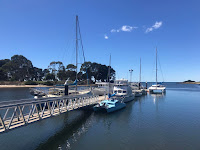
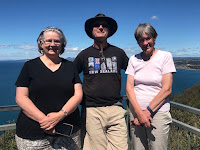


We arrived at the dock and were soon escorted by Jan and Linda on a area tour that included Table Cape Lighthouse



It is hard to imagine that this tiny LED light (last photo) is all that it takes for Table Cape Lighthouse to beam 16nm to sea (with a little help from the lens)!
Just before we left, rather than driving us home, Linda and Ian offered to lend us their spare car for a couple of days so we could see more of the area. Well, that was nice!
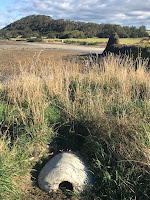


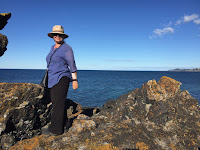


We swung by the Penguin nesting area (where the local scouts have made nesting 'igloos' to help protect the birds), and we also visited Fossil Bluff before dark
The next day, we drove up into the hills to Cradle Mountain National Park to hike the loop trail around Dove Lake. It was a bit cold and overcast, but the views all around the lake were still just so stunning, with the steep spires of Cradle Mountain looming overhead. All of the trails in the park are built with monumental effort. Since the area can be quite boggy, almost the entire trail system consists of raised boardwalks fitted with sturdy handrails. The rest is made from heavy stones positioned to make stairs or flat footpaths.
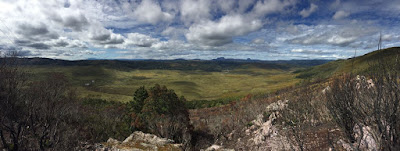

We stopped at Vale of Belvior Lookout (top picture)
but focussed on time in Cradle Mountain National Park
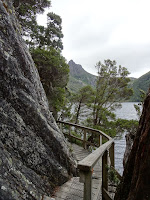
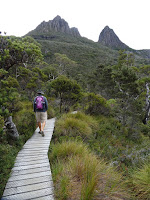

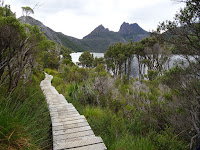

Our 6km circuit around Dove Lake was a bit overcast, but a pleasant stroll with plenty of WOW scenery to enjoy (just not great for photos)
We wanted to hike every trail in the park. However, we had a dinner invitation with the group at Ian and Linda's house, and we were looking forward to it; that was dictating our time in the park. It was probably for the best, since it is not a good idea to drive through the bush at dusk as the quantity of the roadkill along the way in had attested.
Since the park is a sensitive area for wildlife, the road to Dove Lake is only one lane and only accessed by busses from the Visitor Center car park. As we were being driven out of the park, someone on the bus spotted wombats grazing in the hills above. Half of the occupants, ourselves included, decided to make an impromptu stop and get the next bus so that we could go see them.


Kyle was thrilled to see wombats in the wild, we both were but Kyle thinks they are the cutest thing EVER!
Wombats are just too cute. They look like super-sized guinea pigs. After seeing them in captivity (at the visit to the Bonorong Sanctuary during our Hobart based roadtrip), we thought we would never spot one in the wild. For some reason, I was expecting them to be hidden in the undergrowth of thick forests. Here, they were out in the open, munching their way across the grassland. All we had to do was stare at each rock or clump of grass for a while. If it moved, it was a wombat. That was worth the stop, but it was now uncertain whether we would make it to dinner on time.
We made it ten seconds before the appointed hour, just as if we had planned it that way all along. Dinner was delicious and we had an amazing view of the sunset all of the way back to our first anchorage at Table Cape.
We were having a little fun with Bill, who kept trying to tell us he didn't like whisky, just to wind us up. Since we knew this, we had brought a delicious bottle of Shiraz that we liked from Jacob's Creek in the Barossa Valley. It was matured in whisky barrels. He liked that. We all did. Given enough time, I think we could turn him.


Good food, good company, AND whisky - what a night!
Feeling sufficiently tipsy, except for Maryanne, who agreed to drive, we were just getting ready to leave when Ian produced a bottle of his own whisky. This was not merely a whisky that he owned, but one that he had commissioned. He had gone in on a whole barrel, into which a local distiller would age their latest run.
Well, things didn't go exactly as planned. The distiller was (allegedly) mostly pocketing people's investments. They also did things like sell several barrels with the same lot number, which is a big no-no to Customs and Excise. In the end, after a prolonged negotiation, they were shut down and Ian got most of his investment back. Included were two bottles, one from 'his' cask and one from another. Each is valued at more than we would ever likely pay for a bottle of whisky. That was before you even factor in that they are two of only a handful in existence.
We thought he was just showing us the bottle with it's amusing label, part of which was redacted "for legal reasons", and its carefully applied wax seal. Then, he decided that since we were such aficionados, he cracked through the wax and produced a serving for us each to try. Mine seemed especially generous. Oh, that was some good stuff! My only regret is that we could never buy one and the only place we know that has it only has two-thirds of a bottle left. Thanks, Ian! That was quite an honor.
We still had their car for one more day, so we drove back inland to see the little town of Waratah, set in the hills beneath Mt Bischoff at the edge of the remote Tarkine wilderness district. On the way we drove the windy road through Hellyer Gorge and took the short walk along the river before continuing on to Waratah. The town is quiet and pretty, set in a valley of the most spectacular biodiversity. The only detractor is the scar of the tin mine (once the world's largest) high above. The mine used water wheels at the falls in the center of town to power its crushing equipment, known as stampers. Waratah is the first town in Australia to be powered by hydroelectricity using those same falls as a power source.
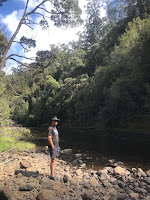



A stop at Hellyer Gorge on the way
We took a walk down the path to the lookout at the bottom of the falls, which are pretty impressive. We were both amazed to see that there were so many different types of foliage that the opposite side of the gorge seemed to only have enough room for one of each type. No monoculture there.



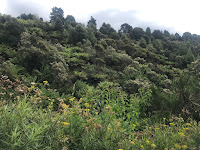









Scenic old mining town of Waratah
Back in the town, we visited the small, but comprehensive museum, which of course included so many mineral samples that my eyes started to glaze over a bit at the end. They really like their mining up here. Then we went to the stamper.
After the main mine's production tapered off following a tin price drop in 1923, a few locals stayed behind and kept processing what was left. One beloved man liked it so much that he built a smaller version of the big stampers so that he could spend his retirement crushing rocks into gravel. When he passed, the community disassembled it, moved the whole thing into town and then rebuilt it piece by piece. Now you can go inside the shed where it is housed, read all about it and, best of all, push a button and see how it works.
For some reason, we had been expecting something like one of those scale models of steam engines that you see now and then, thumping along, minus the steam, while the little electric motor that powers it is whirring away. The stamper is not like that. Maryanne pushed the button and the whole thing roared to life. WHAM! WHAM! WHAM! WHAM! The whole building started shaking and the ground started pulsing. EVERYBODY in town knew that Maryanne had pushed that button.
During the mine's heyday, there were seven much bigger stampers running twenty-four hours a day, six days a week. It was said that Sunday was the only day you could hear the birds singing. That's the sound of progress, son.
”What?”
”I say, THAT'S THE SOUND OF PROGRESS, SON!”
”WHAT?”
I doubt any of them could hear much of anything. Ear plugs were not a thing back then.


Time for a walk along the River Inglis


We were so glad to have been guided in to Wynyard - thanks Jan!















